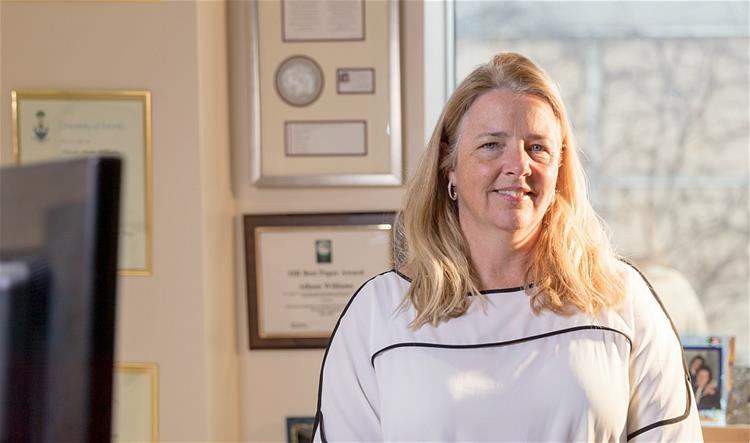
Published: March 26, 2018
They take their aging loved ones to specialist appointments. They make meals, they do laundry, they help monitor medications. They even assist with very personal tasks like bathing, feeding, and dressing. And they do it all while juggling the demands of a full or part-time job.
Known as ‘carer-employees,’ they are among the 5.6 million Canadians who are providing care for aging, chronically ill, or disabled family members or friends while continuing to work in paid employment.
“As our population ages, there’s an increase in the expectation for family members to carry this additional, informal caregiving role while continuing to work, usually full-time,” says Allison Williams, a professor in McMaster’s School of Geography and Earth Sciences and Canadian Institutes for Health Research (CIHR) Chair in Gender, Health and Caregiver Friendly Workplaces. “This is having a significant impact both on employees and on workplaces.”
Now, a new set of guidelines developed by Williams, in partnership with the Canadian Standards Association (CSA), are providing employers with a set of tools designed to help workplaces better support these workers.
“For many of these employees, it can be very difficult to bear the multiple and often conflicting responsibilities of work and home,” she says. “We frequently see anxiety and depression which often moves into more acute health issues that can require a disability leave from work. So it becomes counterproductive for the workplace if employers don’t have policies that support carer-employees.”
The guidelines, developed in consultation with 30 partners across a number of sectors, offer employers practical solutions, information and case studies to help them implement policies and programs aimed at creating more accommodating workplaces.

“What the guidelines do is provide a set of go-to possibilities for Human Resources personnel, managers and CEOs,” Williams explains, adding that the guidelines were designed to be flexible and offer tools for both large and small businesses and organizations, regardless of sector or industry.
The guidelines suggest a number of ways for employers to support carer-employees, from offering more flexible work arrangements like job sharing and the ability to work from home, to modifying employee assistance plans and benefits packages, as well as providing counseling services and options for paid or unpaid leave.
Williams says the guidelines also suggest ways for employers to create a more supportive work environment by providing manager and co-worker training, holding educational workshops, and creating support groups – all of which can help workplaces be more sensitive and responsive to the pressures facing carer-employees.
“Culture change within organizations is the really critical piece and a lot of that is about education,” says Williams. “We need to ensure that supervisors and managers at all levels, as well as co-workers, understand that this is a workplace issue, not just a private issue, and that it’s the responsibility of workplaces to support carer-employees as they try to balance multiple demands.”
The guidelines stem from a five-year research program led by Williams and funded jointly through the CIHR and a Social Sciences and Humanities Research Council (SSHRC) Healthy Productive Work Partnership Development Grant.
Williams’ research found that carer-employees are typically female, between the ages of 45 and 65 and are among the most experienced members of the workforce. They have elderly parents and often also have children of their own. Their caregiving responsibilities can range from relatively simple support tasks like taking aging family members to appointments, to caring for those with complex conditions such as Alzheimer’s.
According to Williams, carer-employees frequently experience poor physical and mental health outcomes as a result of the strain of managing competing responsibilities, leading to burn-out, increased absenteeism and reduced productivity. It can even result in carer-employees leaving the workforce altogether – negatively impacting both employers – who have invested in training – as well as employees.
“We know that income is the number one determinant of health,” says Williams. “So if employees are losing their salary and their pension by having to leave work, then they’re really putting themselves in jeopardy for long-term negative health consequences.”
Williams says that in the past, care for those with chronic illness, disabilities, or cognitive impairments like dementia, was provided through the health care system. But with the closure of hospital beds, a shortage of publicly funded long-term care homes, limited publicly-funded home care, and the high cost of private care, more people are living in the community longer, leaving it up to family members and friends to provide care.
It’s an issue that, according to Williams, will only grow over time, with both employees and workplaces increasingly feeling the impact.
“Employers really need to play a role here,” she says. “There’s a lot of potential for the workplace to accommodate and assist carer-employees through policy innovation that supports their workers in managing this critical, and growing work-life balance issue.”
The Carer-inclusive and accommodating organizations Standard (B-701-17), and associated Implementation Guide/Handbook, is available for a fee on the CSA website.
Source: This article was first published on Brighter World. Read the original article.​

